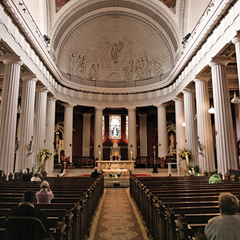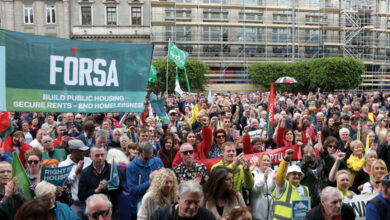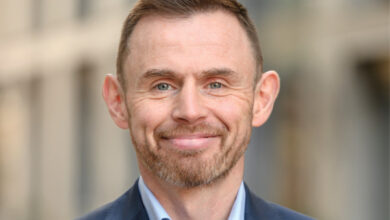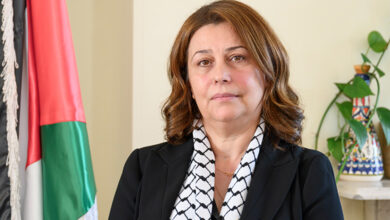Catholic church’s future in Ireland
 As Dublin prepares to host 100,000 people at the 50th International Eucharistic Congress, the Catholic Church in Ireland is still searching for a clean break from the past. Stephen Dineen reports.
As Dublin prepares to host 100,000 people at the 50th International Eucharistic Congress, the Catholic Church in Ireland is still searching for a clean break from the past. Stephen Dineen reports.
The last time a Eucharistic Congress was held in Ireland, thousands attended processions, Dublin was laden with floral arrangements and bunting, and a million people gathered in the Phoenix Park for an open air mass.
Seventy-nine years on, Dublin will host the international congress again, from 10-17 June. A series of masses, workshops, talks and concerts will take place, but with little national excitement in advance. The church is heavily bruised by a litany of abuse scandals, not least the latest allegations of failure by Cardinal Brady to disclose information of abuse back in 1975. It also faces decreasing participation and is grappling with itself in a more secular society, vastly changed from that of 1933.
The most recent report to provoke debate on its role was that of an apostolic visitation in Ireland, published in March. Visiting archbishops and cardinals met with seminary representatives, members of the Conference of Religious in Ireland, abuse victims and the National Board for Safeguarding Children in the Catholic Church.
In its report, the visitation made a number of observations:
• the church’s child protection guidelines are being followed;
• greater concern needs to be shown to the intellectual formation of seminarians;
• a deeper formation of young people’s faith is needed, as is a new focus for the laity; and
• there is a widespread tendency among priests, religious and laity to hold theological variance with the teachings of the magisterium (i.e. the church’s teaching authority), something which needs particular attention.
Reference was made to re-configuration of the church’s diocesan structure in Ireland, which the Holy See and Irish bishops have already started to examine.
Since the visitation’s report, relations between the Irish church and the Vatican have deteriorated with revelations that six priests have been censured by Rome for their outspoken views and publications. One of the censured priests, Redemptorist Fr Tony Flannery, told eolas that he is currently barred by the Vatican from making any public comments.
For Garry O’Sullivan, editor of The Irish Catholic, “what you’re seeing right now is the final destruction of any real faith in the hierarchical church in Ireland.” Renewal will come from “the ordinary priests, the parish, lay people getting involved in the parish, and the vibrancy of parishes.” He adds: “I think there is going to be a need for people to know what it is to be Catholic, what the Catholic teachings are, and then to decide whether or not they want to sign up to them.”
Catholic influence in Ireland remains strong, however. The 2011 census in the Republic found that 3.83 million people (84.6 per cent) of those resident in the country regard themselves as Catholic, down from the 87.3 per cent in 2006. Weekly or more regular church attendance among Catholics is 51.6 per cent, according to the 2009-2010 European Social Survey. Regionally, the highest proportion of Catholics attending Mass once a week is in Ulster (47.4 per cent), compared to 23.8 per cent in Dublin. Sixty per cent of Catholics over 75 attend Mass once a week, compared with only 19.2 per cent of those between 25-34 years of age.
The church is involved in healthcare. The Temple Street Children’s Hospital, for example, is owned by the Sisters of Mercy (as is the Mater Hospital), who are represented on the board of directors. The hospital is primarily funded by the HSE but the board appoints management. The Archbishop of Dublin is chairman of the boards of management at the National Maternity Hospital and Our Lady’s Children’s Hospital Crumlin.
2,841 primary schools (89 per cent) and 359 post-primary schools (49 per cent) have Catholic patronage. Education Minister Ruairi Quinn plans to create a more pluralist primary school patronage system. In April, the report of the advisory group to the forum on patronage and pluralism in the primary sector was published. It concluded that in areas where the population is stable and where there is a cluster of denominational schools but also parental demand for alternative school patronage, patronage should change.
Irrespective of implementation, change is already happening. None of the 16 new primary schools to open in the next two years will be of Catholic patronage. The church says it did not apply for patronage as it had adequate Catholic provision in the areas. Since 2008, the department has been rolling out a new ‘community national school’ model. These are state-sponsored, multi-faith schools.
The drive to pluralise primary schooling is supported by the findings of an Irish Primary Principals’ Network survey, conducted by RedC, of 729 adults. Thirty per cent of parents with children under 16 would prefer to send children to a primary school run by a VEC; 27 per cent would opt for a church-run primary school; 24 per cent for a multi-denominational school (e.g. the Educate Together model) and 20 per cent of parents for a school with no patron.
A place for religion in schooling is desired, according to the survey. Sixty-seven per cent of parents said that religious instruction and preparation for the sacraments should be taught during the school day.
Relations between the church and the new Government have been less than harmonious. In July, following publication of the Cloyne report, Enda Kenny told the Dáil that the dominant Vatican culture was one of “dysfunction, disconnection and elitism” and spoke of how “the rape and torture of children were down-played or managed to uphold the primacy of the institution, its power, standing and reputation.” On 16 January, the Irish embassy to the Vatican was closed, a move that Fianna Fáil and some Fine Gael TDs have opposed.
Relations between the state and the Vatican are more reassuring perhaps for some Catholics in Northern Ireland than might be the case under Dublin rule. A joint communiqué issued by the Holy See and the British Government following a ministerial visit to the Vatican in February acknowledged the church’s significant contribution to the good of British society.
Fr Eugene O’Neill, parish priest of St Mary’s church, Glengormley, said earlier this year that many Catholics are re-thinking their nationalism. While the Republic had become “a cold house for Catholicism”, he saw Queen Elizabeth and senior British Government ministers as defenders of the faith.





